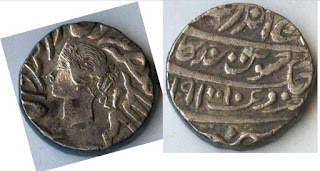Bharatpur State is located in Rajputana in northwest India. Bharatpur was founded
by Balchand, a Jat chieftain who took advantage of Mughal
confusion and weakness after the death of Aurangzeb to seize the area. In 1756
the ruler at that time, Suraj Mal, received the title of Raja. Bharatpur became
increasingly associated with Maratha ambitions and, in spite of treaty ties to
the East India Company, assisted the Maratha Confederacy in their struggles
against the British. This gained them few friends in British circles, but the
early attempts by the British to force the submission of Bharatpur fortress
proved abortive. In 1826 however, the British took the opportunity offered by a
bitter internal feud concerning the succession finally to reduce the stronghold.
The rival claimant was exiled to Allahabad and Balwant Singh, then a child of
seven, was placed on the throne under the supervision of a British Political
Agent. From that time onwards Bharatpur came under British control until it
acceded to the Indian Union at Independence.
After the first Great Indian Freedom Fight (what the British would
call the Great Indian Mutiny) in 1857 the last Mughal Emperor, Bahadur Shah,
was taken prisoner and exiled to Rangoon. After the Allahabad Proclamation of the
1st November 1858, most of the Indian Princely States issued coins in the name
of the British overlord, instead of the Mughal emperor. The coinage of
Bharatpur from 1858 onwards is particularly interesting as it issued coins
showing the effigy of Queen Victoria.
1) KM#176, Bharatpur, Rupee
AD1858/VS1910, mint: Bharatpur
2) KM#166.2, Bharatpur, Rupee AD1859/VS1917, mint: Braj Indrapur
(=Bharatpur)
Close copies of the Bharatpur coinage were struck at Bindraban. The
area, after 1803-05, passed to the East India Company. The coinage could only
be semi-official as it was British territory at the time of issue. The coins are
of lower fineness and it is suggested they may have been locally struck for
charity for the devotees who frequented the place as being the playground of
Lord Krishna and used for payment of the Brahmins. Mostly one comes across the
¼ Rupee denomination. Rupees and half rupees are scarce.
RULERS
Ranjit Singh,
AH1190-1220/1776-1805AD
Randhir Singh,
AH1220-1239/1805-1823AD
Baldeo Singh,
AH1239-1241/1823-1824AD
Durjan Singh,
AH1241-1242/1825-1826AD
Balwant Singh,
AH1242-1269/1826-1853AD
Jaswant Singh,
AH1269-1311/1853-1893AD/VS1909-1950
Ram Singh, 1893-1900AD
Kishan Singh, 1900-1929AD
KM# 166.2 (Could be a variation):


No comments:
Post a Comment